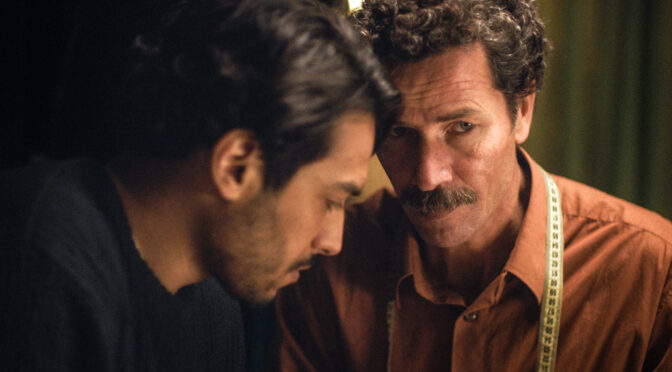In 2019, the Moroccan government prosecuted 122 people for same-sex sexual activity. It remains illegal to this day as per the 1962 penal code, which prohibits “lewd or unnatural acts” between individuals of the same sex. In Maryam Touzani’s THE BLUE CAFTAN, a delicate and sophisticated queer drama, the illegality of the protagonist’s sexuality is in the subtext.
Instead of playing it like Georgia Oakley’s wonderful BLUE JEAN, where the vindication of Jean’s queerness is on full display, THE BLUE CAFTAN is instead enriched by the knowledge that the sexual actions of Halim (Saleh Bakri) are illegal.
Halim and his wife, Mina (a brilliantly expressive and captivating Lubna Azabal), run a caftan shop in the Moroccan city of Salé. The store is not hugely profitable, with Halim stubbornly refusing technological advancements that would speed up the process. To help increase the rate at which Halim can produce caftans, they hire an apprentice, Youseff (Ayoub Messioui). His arrival disturbs the amicable status quo the two have fostered for 25 years. Halim and Mina have long harboured a secret, kept knowingly silent between them: Halim is gay.
One of the many questions the lean but acute script plays with is that this couple struggles to make ends meet, yet they’re hiring an apprentice to help. But the obscurity within the script about finances, Halim’s sexuality, and why Mina is quickly unnerved by Youseff’s appearance are soon answered. The details within the fine lining of THE BLUE CAFTAN’s characters unravel unceremoniously, the story slowly picking at the seams of what makes the central trio tick as they evolve and discover more about themselves. The finely-tuned script – a declaration of love is the only moment that feels slightly par-baked – is enigmatically performed until the facade each character presents falls away like silk trimmed from the caftan.

“They say the eyes are the window to the soul. In THE BLUE CAFTAN, a film that rewards patience, Touzani’s decision to keep the camera lingering on her stars’ bright, pained eyes in intimate moments enhances the emotional connection behind them.”
A prominent element that keeps THE BLUE CAFTAN needle-sharp is that Halim mandates stitching everything by hand. It is a rejection of modernity, keeping hold of the tactile values his father taught him. He maintains that the classic caftan hem is ideal, as much as his eager customers wish for a more modern, slicker, tighter look. An interesting contrast is set up by having Halim embrace a regressive attitude towards more modern ideals, including barely defending Mina from the police when they are out past curfew. While countries are progressively legalising homosexuality, Halim’s ideas around modernity contradict the sexuality he has to hide. These ideas of sexual repression and rejecting modern ideals run playfully parallel.
They say the eyes are the window to the soul. In THE BLUE CAFTAN, a film that rewards patience, Touzani’s decision to keep the camera lingering on her stars’ bright, pained eyes in intimate moments enhances the emotional connection behind them. The film floats through these emotional beats, never feeling overwrought. Touzani chooses to observe their lives through the pleasures that the mundane provides. Soft, intimate caresses of fabric, a pipe blown and shared between the couple or the tiny specs of mould growing on the tangerines that the couple buy together combine to create a tranquil, vibrant film. It’s also in the sharing of food and laughter between the trio as the gentle tone placates into an achingly rich tale of conquering love.
THE BLUE CAFTAN is beautifully sewn together with great care and attention as Touzani refuses to let the film descend into melodrama. An unnecessary runtime perhaps frays the edges, but as Halim says to his protégé, referring to the caftan’s spare fabric, “If you cut too much, there’s no going back”.

